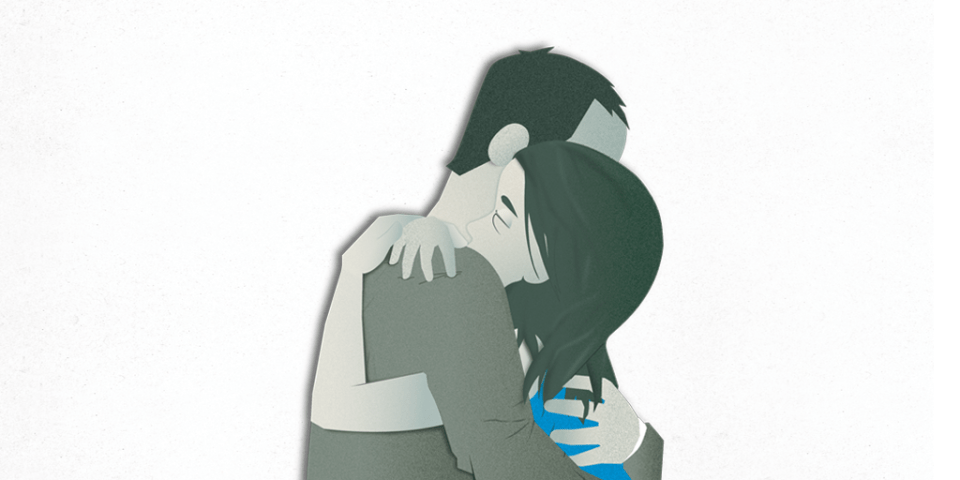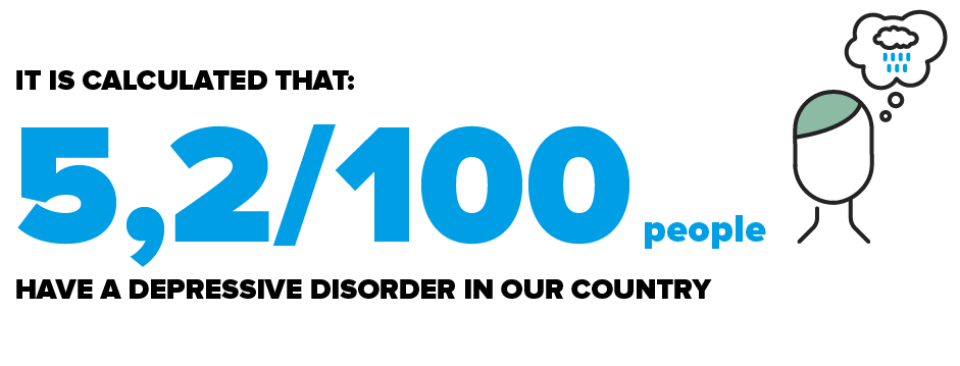Depressive disorder is a disease which main sympthoms are sadness, the loss of interest, or lack of concentration. It affects more than 300 million people all over the world, and is the main cause of disability. It has nothing to do with age or social conditions. It can be treated, and if treatment is followed correctly, it can lead to a remission of the disorder. Medication and psychotherapy is the cornerstone of the treatment.
Depressive Disorder explained in first person
It’s important to impress on the patient and their family that they don’t have to force themselves to feel happy, to think positive, want to do things, and be cheerful. This is an illness, a disorder. It isn’t something anybody chooses.
A positive message, just what my doctor told me “it’ll take a while, but you won’t always feel like this, we’re here to help.” And it’s true; he was right.
Depressive disorders are a group of illnesses that have the presence of pathological sadness as a symptom in common. In medicine the sadness symptom is defined as the presence of a more intense feeling of sorrow than expected, and persistently limits the person to be able to perform their usual activities.
| Non-pathological sadness | Sadness as a symptom of illness |
|---|---|
| Intensity proportional to the situation | Intensity disproportional to the situation |
| Intensity not maintained with time | Intensity maintained with time |
| Absence of other symptoms of depression | Presence of other symptoms of depression |
| Non-limiting | Limiting |
Types of depressive disorder
Based on the most common symptoms, to the response to various existing treatments, and the short-term, medium-term, and long-term prognosis, the depressive disorders are divided into:
Adjustment disorder with depressed mood is characterised by:
- The patients themselves identify a recent trigger (stressor) as the origin of the symptoms.
- The trigger (or its direct consequences) is still present.
- The exposure to intense environmental situations leads, temporarily, to an adequate performance. Said another way, if the person affected by an adjustment disorder is shown an intense stimulation (for example; a funny video of their grandchild), this is due to the new focus of attention and expresses a logical feeling to that situation.
Dysthymic disorder or dysthymia is characterised by:
- Chronic presence (months or years, not days or weeks) of a feeling of dissatisfaction, a feeling of downheartedness and despondency that causes sadness and a poor daily functioning of the person. Apathy and the loss of initiative predominate over the loss of hope and expectations.
- The patients describe their feeling of sadness as qualitatively similar to the normal feeling of sadness. What is remarkable for the individual patient that suffers from it, is its persistence or chronicity and apparent absence of specific triggering situations.
- As occurs with the adjustment disorder, the exposure to intense environmental situations gives rise, temporarily, to an adequate performance.
- Often, but not always, these patients have a very emotional and/or very dependent baseline personality.
The depressive episode (or major depression) is characterised by:
- The patients describe their feeling of sadness as qualitatively similar to the normal feeling of sadness, considering it a new experience. What characterises it is the existence of a decrease in the emotional response to situations of, theoretically, marked emotional depth. This fact explains that the patients very often do not focus their complaint on their sadness, but on the feeling of fear and anguish of the emotional block from which they suffer.
- Unlike what happens in adjustment disorder and in dysthymia, the exposure to intense environmental situations leads to little or no variation in their mood state (that is to say, their mood is not easily changeable by determined environmental situations).
|
Table comparing the main characteristics of sadness in each one of the three most common depressive disorders |
||
|---|---|---|
| Adjustment disorder | Dysthymic disorder | Depressive disorder |
| Sadness focused on the problem or acute stress | Chronic feeling of sadness, with dissatisfaction, fury and/or deception | Feeling of incompetence, bewilderment, alert and fear of the lack of their emotional responses |
| Temporary improvement to intense stimulations | Temporary improvement to intense stimulations | Absence of frank improvement to intense stimulations |
Is an Anxiety Disorder the same as a Depressive Disorder?
The target symptoms that cause the disability in a depressive disorder are the loss of hope and/or the loss of self-confidence. On the other hand, in the anxiety disorders, the change of mood does not exist as a primary symptom; in the anxiety disorders, the characteristic initial symptom is the feeling of loss of control, either in the physical sense (by presenting with non-associated physical symptoms—general anxiety disorder—or of sudden appearance and of short duration, but recurrent in time—panic disorder), or in the cognitive sense (due to having undesired menacing reiterative thoughts—compulsive obsessive disorder, hypochondriac disorder, dysmorphophobic disorder) or in both senses (any of these when they have suffered them for months or years).
Regardless of whether the depressive disorders and anxiety disorders are two disorders with clearly differentiated initial symptoms, it is certain that, the anxiety disorders of long onset can often present with clinical manifestations that can make it difficult to make a differential diagnosis with a depressive disorder. Although less often, sometimes this same statement can be applied to long-term depressive disorders, but in the opposite sense (depressive disorders to which symptoms are progressively added that make the differential diagnosis with an anxiety disorder difficult).
|
Depressive disorder versus anxiety disorder |
|
|---|---|
| Depressive disorder | The initial symptom is the loss of hope and/or the loss of self-confidence. |
| Anxiety disorder |
The initial symptom is the feeling of loss of control:
|
How many people are affected by Depressive Disorder?
According to data published by the World Health Organisation (WHO), in Spain, every year, 5.2 persons per 100 inhabitants have a depressive disorder.
The prevalence of depression varies slightly from one area of the world to another; the lowest rates are observed in the Western Pacific Region (3.6 individuals per 100 inhabitants), and the highest in Africa (5.4 per 100 inhabitants).
Depressive disorders are approximately two times more frequent in females than in males. Likewise, the prevalence varies with age. The higher the age, there is more risk of suffering these types of illnesses. The highest incidence is seen among women greater than 55 years (7.5 per 100 inhabitants). Depressive disorders also affect children and adolescents, although its prevalence is less than among adults.
What is Spring Asthenia?
In medicine asthenia is defined as a persistent feeling of fatigue and a general lack of vitality, both physical and psychological, which is accompanied a loss of motivation and interest due to the environment. With the arrival of spring some individuals refer to having asthenia. This is popularly called, spring asthenia.
There are no statistics published that would enable us to scientifically know what proportion of the population suffers from spring asthenia. The percentage of people that suffer from spring asthenia probably varies a lot from some geographic areas to other. The greater intensity of the climate changes from one season to another and to a greater abruptness in the appearance of these changes, the greater probability of developing spring asthenia.
Causes of spring asthenia
The causes of this phenomenon are not exactly known. Given that the different physiological mechanisms of our body are clearly dependent on the hours of light and darkness, it has been suggested that the appearance of spring asthenia could be a normal sign of the adaption process of the body to the new conditions of brightness. This fact justifies that, from a strictly medical point of view, spring asthenia may not be considered as an illness in itself.
Symptoms of spring asthenia
|
Most common symptoms of spring asthenia |
|---|
|
Most characteristic symptoms:
|
|
Other symptoms:
|
The presence of insomnia is not a characteristic symptom; however, the subjects that suffer from spring asthenia, despite having slept well, have the feeling the sleep has not been repairing, thus, it is usually more difficult than usual to get up and start daily activity. The symptoms of spring asthenia are mild. Although they interfere with daily activities, the do not prevent maintaining daily obligations. One very important characteristic of spring asthenia is that the duration of the symptoms is relatively short. There is usually a spontaneous remission of the symptoms in a few days or weeks.
Diagnosis of spring asthenia
There is no objective diagnostic test to make a diagnosis of spring asthenia. The taking of an adequate clinical history and a correct physical examination will be the key factors for arriving at its diagnosis.
The ideal professional to detect spring asthenia is the family doctor, since they have the elements necessary at hand in order to make the best diagnosis: knowledge of overall health and personal history of the patient, the assessment of the intensity of the symptoms and their duration and, if required, the carrying out of appropriate complementary examinations.
As regards the treatment of spring asthenia, the first thing we must remember is that mentioned earlier: we must think in terms of normality (the adapting of the body to the new environmental situation), and not of a disorder. There is no scientific evidence that allows us to suggest that there is a suitable pharmacological treatment for spring asthenia. All the experts agree in pointing out the main key to combat, and prevent spring asthenia, are not pharmacological treatments, but the maintaining of healthy life habits. In this sense, with the arrival of spring, various measures could help in the reduction, both in the incidence and in the intensity of spring asthenia.
|
HEALTHY LIFE HABITS |
|---|
|
Professionals and patients explain how you live with the disease
Substantiated information by:


Published: 3 April 2018
Updated: 3 April 2018
Subscribe
Receive the latest updates related to this content.
Thank you for subscribing!
If this is the first time you subscribe you will receive a confirmation email, check your inbox




